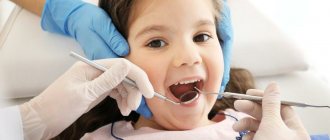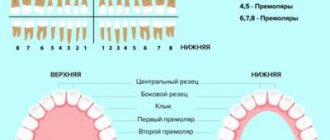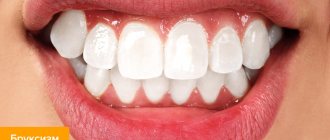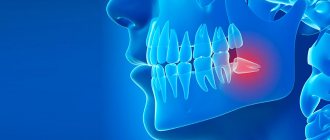Crooked baby teeth
Baby teeth serve a child for only 6–8 years, so their position does not always require correction, however, the state of the baby occlusion can be used to judge how correct the eruption of permanent teeth will be.
Gaps between baby teeth are normal, but rotation and crowding are no longer the case.
Rotation of baby teeth
The same applies to the bite: it should not be asymmetrical or open, the lower teeth should not completely overlap the upper ones. In such a situation, you need to consult an orthodontist.
The doctor may determine:
- Why did the disorder occur at such an early age? Are bad habits to blame (for example, feeding from a bottle at an age when a child should already eat with a spoon), poor posture, some congenital characteristics, etc.
- How can this be corrected? Refer the child to an orthopedist for additional examination or simply advise parents on how to organize nutrition.
- When should you be examined again? Follow-up in orthodontics is very important; appointments are usually recommended every 6–12 months. Then you can see in dynamics how the condition of the teeth changes.
Why is treatment necessary?
In the human body, everything is interconnected; if the teeth are incorrectly positioned, a malocclusion is formed and many diseases of the body arise:
- First of all, this is inadequate chewing of food, which leads to gastrointestinal diseases.
- Speech function may be impaired, because the child swallows or has difficulty pronouncing sounds.
- Disorders occur in the temporomandibular joint.
- An improper redistribution of chewing pressure occurs in the oral cavity, excessive stress occurs on some teeth, and subsequently diseases of the teeth and gums occur.
- In addition to diseases and functional disorders, aesthetic disturbances of the face occur, an incorrect profile is formed, and underdevelopment of the jaws is observed.
If a child’s baby teeth grow crooked, then with a 90% probability the permanent teeth will erupt out of alignment. Lower primary teeth are often crooked - crowding, which makes it difficult to maintain hygiene and risks rapid tooth decay.
Ribbed teeth
Why do ribbed or “wavy” teeth grow? This is the norm. The front surface of the teeth should be even and smooth. But the cutting edge of permanent teeth is ribbed when they erupt. This is especially noticeable on the incisors.
Wavy edges of newly erupted teeth
On the cutting edge of the teeth, the thickness of the enamel is greater than on the front or side surfaces. It is quite enough for the teeth to wear down a little naturally during chewing. Therefore, soon the lower edges of the teeth will become smooth.
But this will only work if the teeth are closed correctly, that is, there is adequate load on the cutting edges. If the teeth are crowded or tilted to the sides, the lower (ribbed) part will not grind down and the visual defect will remain. At least until the bite is corrected.
If the very first teeth are crooked
The first lower incisors erupt between the ages of six months and one year. They often grow in an "L" shape. This is the norm. This situation definitely does not require any treatment. By the time of complete eruption, the units are aligned and become correct.
If parents are very worried, they can speed up the process of stabilizing the position of the incisors. To do this, the baby should be given to drink from a bottle with a special tight nipple with a small hole. When using it, the baby will make more effort when sucking.
Another situation that should not worry is the even spacing between the first teeth. They disappear when the chewing units erupt. Dentists recommend paying attention only to uneven and too wide diastemas. They most often have to be closed with plates and braces.
Yellow teeth in a child
Yellowing of enamel is not always a consequence of bad habits. Sometimes it occurs in children too.
If the enamel is uniformly yellowish, this is a congenital feature that does not in any way affect the strength of the teeth. If the yellowing is not uniform, but spotty, the spots are more dull than the rest of the enamel surface, this is fluorosis. With it, the spots can be white, but they will still stand out due to their matte surface. Specks appear due to the increased fluoride content in drinking water.
Yellow spots on baby teeth
Yellowing of enamel in children cannot be corrected. All aesthetic procedures are carried out with permanent teeth.
Aligners: pros and cons
Transparent aligners, which are applied to the entire dentition, where each unit has a separate cell, have become a real breakthrough in modern orthodontics. The removable design does not cause discomfort, it is soft and aesthetically attractive. There are other advantages:
- ease of maintenance and operation;
- preservation of the color of the overlays;
- safety for mucous membranes;
- no discomfort when wearing;
- the material does not cause allergies or other adverse reactions;
- short duration of therapy;
- Possibility of use for preventive purposes.
Despite many advantages, until recently this method was contraindicated for persons under 14 years of age because:
- it affects not only the crooked milk teeth that have emerged from the child, but also the maxillofacial apparatus as a whole;
- designed for permanent bite;
- Wearing aligners requires self-discipline, which is often absent in preschool children and primary schoolchildren.
Medicine does not stand still, and manufacturers are now offering children's designs suitable for the youngest patients.
Disadvantages of this type of mouth guard:
- high price;
- long production time (up to one and a half months);
- failure to correct serious anomalies;
- if one cell is damaged, the entire structure can be significantly damaged;
- more time is required for hygiene procedures.
Incorrect occlusion
Is it possible to judge from the malocclusion of baby teeth what the permanent bite will be like? To some extent, yes, since the reasons for the formation of incorrect occlusion do not depend on whether they are permanent or baby teeth.
Examples:
Open bite: the teeth do not close together, the chewing process is already disrupted
Straight bite: teeth close together at the edges, decay faster, and may fall out prematurely
Regular monitoring by a pediatric dentist and, if necessary, an orthodontist is the key to ensuring that serious problems are detected in a timely manner. It is recommended to start correcting the bite as soon as all the permanent teeth have finished erupting - then the treatment is easiest to carry out.
Other articles:
5 reasons to cure caries on a baby tooth without delay
How to help your child not be afraid of dentists
If a child does not want to be treated by an orthodontist...
Let's sum it up
The issue of malocclusion should be resolved in infancy (using pacifiers) or primary school age, that is, as early as possible. Otherwise, serious physical and mental consequences are possible. Before developing therapeutic tactics, professional doctors first determine why children grow very crooked teeth (photos of uneven jaws and corrected versions can be seen below). In case of sufficiently serious anomalies of the maxillofacial apparatus that worsen the quality of life of a small person, surgical intervention is indicated. In other situations, you can get by with less radical methods (plates, trainers, braces), the choice of which depends on the patient’s age, his personal preferences and the financial capabilities of the parents
Prevention Tips
How to prevent the formation of an uneven bite? There are some tips:
- provide the child with proper and balanced nutrition according to his age from the first years of life;
- closely monitor the child’s health;
- prevent the formation of incorrect habits, such as constant chewing on one side or sucking fingers;
- Carry out thorough oral hygiene every day.
It should also be noted that once a child reaches 1 year of age, he should be weaned off pacifiers. The fact is that mechanical action changes the structure of a child’s front teeth. The pacifier can be replaced with special vestibular plates that repeat the anatomical features of the structure of the child’s teeth.
Alignment Methods
For crooked teeth, dentists recommend starting correction as early as possible. This is necessary to prevent dangerous consequences. Today there are many ways to correct teeth.
- Braces
Crooked teeth corrected with braces are usually permanent. With the help of special plates, problem teeth are attached to metal arches and are gradually pulled into straight positions. The technique is not used in young children.
- Records
- Trainers
Plates are used to correct teeth in children aged 7-12 years. The device may be removable or non-removable. A metal arc with a locking mechanism is attached to the plastic plate. Thanks to the arch, the teeth are gradually corrected. They can be used to correct temporary and permanent teeth.
A gentle way to correct a crooked bite. These are elastic splints that the child wears during the night. Such devices do not interfere with normal jaw growth, but are used infrequently. Why? The elastic material does not apply enough pressure to correct severe defects.
Conclusions. Expert advice
Crooked teeth can appear for various reasons, ranging from heredity to bad habits. Both primary and permanent elements of the dentition grow incorrectly, and the “eights” of wisdom are almost always not formed correctly enough. Tooth curvature is not only a childhood disease. Trauma, age-related changes, or even a love of chewing pencils can cause problem teeth in adults.
It doesn’t matter whether you have one or several crooked incisors, you definitely need treatment. The first thing you need to do is contact a therapist, and then an orthodontist, who will decide what to do with crooked teeth in your situation. There are quite a few treatment methods, each with its own pros and cons. Sometimes the doctor decides to combine several methods, for example, installing braces and prescribing wearing a trainer. In especially severe cases, surgery is used.
Lack of treatment is very dangerous, because when teeth are crooked, the load during chewing is distributed unevenly. The longer the patient waits, the more severely some elements of the dentition wear out, leaving others without work. This leads to premature loss of molars and incisors. This is followed by bone depletion and expensive implant surgery, if it is possible at all. Avoiding such a development of events is not so difficult: you need to visit the orthodontist in time and correct the bite.
Elimination of defects
Dentists draw the attention of parents to the fact that crooked teeth are not just an aesthetic defect that can cause complexes. This is also a problem that can affect overall health in the future. Therefore, elimination of defects should be carried out as early as possible and be thorough and systematic.
Dental correction is especially important if:
- children show signs of pronounced asymmetry of facial features;
- uneven teeth lead to the child chewing food only on one side of the mouth, left or right;
- improper growth of baby teeth leads to pronounced disturbances in diction (for example, a baby cannot pronounce the letter “r”, has problems pronouncing the hard sound “l”, etc.);
- signs of nasal breathing disturbance appear, which, in turn, only aggravate the growth curve of the tooth.
In addition to the structures already listed, myotherapy can be used to correct defects. The technique is aimed at performing a number of exercises that train the facial muscles. Thanks to such training, the face is kept in good shape, the maxillofacial system, including the oral cavity, develops correctly. However, myotherapy requires parents to have a lot of free time.
Devices for correcting uneven teeth
There are several reliable and effective treatment methods. They differ from each other in some respects. To choose the best option, you should talk to a pediatric dentist who treats children’s teeth. Trainers and removable plates.
They can be used from an early age. Recommended age is 4-6 years. In this case, it is necessary to wear trainers every day; they are often worn at night. The significant difference is that the device is removable.
Aligner trays.
They begin to wear them at the age of 16.
You need to wear them constantly and take them off only when eating. Braces.
They are given mainly to persons over 18 years of age. They need to be worn for a long time, on average about two years.











